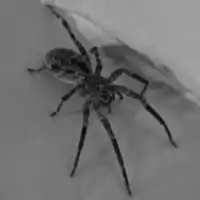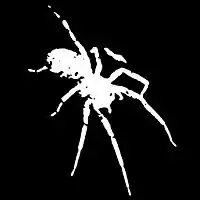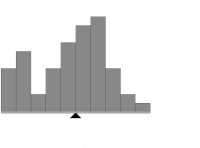Balanced histogram thresholding
In image processing, the balanced histogram thresholding method (BHT),[1] is a very simple method used for automatic image thresholding. Like Otsu's Method[2] and the Iterative Selection Thresholding Method,[3] this is a histogram based thresholding method. This approach assumes that the image is divided in two main classes: The background and the foreground. The BHT method tries to find the optimum threshold level that divides the histogram in two classes.



This method weighs the histogram, checks which of the two sides is heavier, and removes weight from the heavier side until it becomes the lighter. It repeats the same operation until the edges of the weighing scale meet.
Given its simplicity, this method is a good choice as a first approach when presenting the subject of automatic image thresholding.
Algorithm
The following listing, in C notation, is a simplified version of the Balanced Histogram Thresholding method:
int BHThreshold(int[] histogram) {
i_m = (int)((i_s + i_e) / 2.0f); // center of the weighing scale I_m
w_l = get_weight(i_s, i_m + 1, histogram); // weight on the left W_l
w_r = get_weight(i_m + 1, i_e + 1, histogram); // weight on the right W_r
while (i_s <= i_e) {
if (w_r > w_l) { // right side is heavier
w_r -= histogram[i_e--];
if (((i_s + i_e) / 2) < i_m) {
w_r += histogram[i_m];
w_l -= histogram[i_m--];
}
} else if (w_l >= w_r) { // left side is heavier
w_l -= histogram[i_s++];
if (((i_s + i_e) / 2) >= i_m) {
w_l += histogram[i_m + 1];
w_r -= histogram[i_m + 1];
i_m++;
}
}
}
return i_m;
}
The following, is a possible implementation in the Python language:
def bht(hist, min_count: int = 5) -> int:
"""Balanced histogram thresholding."""
n_bins = len(hist) # assumes 1D histogram
h_s = 0
while hist[h_s] < min_count:
h_s += 1 # ignore small counts at start
h_e = n_bins - 1
while hist[h_e] < min_count:
h_e -= 1 # ignore small counts at end
# use mean intensity of histogram as center; alternatively: (h_s + h_e) / 2)
h_c = int(round(np.average(np.linspace(0, 2 ** 8 - 1, n_bins), weights=hist)))
w_l = np.sum(hist[h_s:h_c]) # weight in the left part
w_r = np.sum(hist[h_c : h_e + 1]) # weight in the right part
while h_s < h_e:
if w_l > w_r: # left part became heavier
w_l -= hist[h_s]
h_s += 1
else: # right part became heavier
w_r -= hist[h_e]
h_e -= 1
new_c = int(round((h_e + h_s) / 2)) # re-center the weighing scale
if new_c < h_c: # move bin to the other side
w_l -= hist[h_c]
w_r += hist[h_c]
elif new_c > h_c:
w_l += hist[h_c]
w_r -= hist[h_c]
h_c = new_c
return h_c
References
- A. Anjos and H. Shahbazkia. Bi-Level Image Thresholding - A Fast Method. BIOSIGNALS 2008. Vol:2. P:70-76.
- Nobuyuki Otsu (1979). "A threshold selection method from gray-level histograms". IEEE Trans. Sys., Man., Cyber. 9: 62–66.
- Ridler TW, Calvard S. (1978) Picture thresholding using an iterative selection method, IEEE Trans. System, Man and Cybernetics, SMC-8: 630-632.